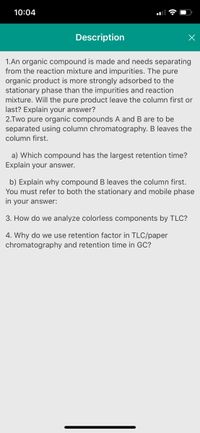
Chemistry
10th Edition
ISBN: 9781305957404
Author: Steven S. Zumdahl, Susan A. Zumdahl, Donald J. DeCoste
Publisher: Cengage Learning
expand_more
expand_more
format_list_bulleted
Question

Transcribed Image Text:10:04
Description
1.An organic compound is made and needs separating
from the reaction mixture and impurities. The pure
organic product is more strongly adsorbed to the
stationary phase than the impurities and reaction
mixture. Will the pure product leave the column first or
last? Explain your answer?
2.Two pure organic compounds A and B are to be
separated using column chromatography. B leaves the
column first.
a) Which compound has the largest retention time?
Explain your answer.
b) Explain why compound B leaves the column first.
You must refer to both the stationary and mobile phase
in your answer:
3. How do we analyze colorless components by TLC?
4. Why do we use retention factor in TLC/paper
chromatography and retention time in GC?
Expert Solution
This question has been solved!
Explore an expertly crafted, step-by-step solution for a thorough understanding of key concepts.
Step by stepSolved in 2 steps

Knowledge Booster
Learn more about
Need a deep-dive on the concept behind this application? Look no further. Learn more about this topic, chemistry and related others by exploring similar questions and additional content below.Similar questions
- Choose all that are definite evidences of chemical reactions Group of answer choices Lighter color when colorless solution is mixed with a colored solution Precipititation Bubbles Evolution of heatarrow_forwardWhy was it necessary to make sure that some solid was present in the main solution before taking the samples to measure Ksp? Select the option that best explains why To make sure the solution was saturated with sodium and borate ions. All the answers are correct. To ensure the dissolution process is at equilibrium. To make sure no more sodium borate would dissolve in solution.arrow_forwardShowing the workings, estimate the lower flammability limit of tetrahydrofuran tetrahydrofuranarrow_forward
- With the images attached please write 3 paragraphs 1st paragraph: objective stated clearly 2nd paragraph: complete condense method describe 3rd paragraph: analysis explained Please please please answer everything it's very important please answer super super fast NOTE: This does not require hands-on experimentationarrow_forward2. The size of a molecule is a factor that can greatly affect solubility of ions. Which molecule is larger, acetone or water? How could this affect the solubility of Nat and CI" ions in each solvent? 3. It is very likely that the acetone partition still contained a fairly good amount of water (and that the water partition contained acetone). Only one of the three concentration units will be affected by the water in the acetone solution. Which one is affected? Explain why, and why the other two concentration units will be unaffected by the amount of water.arrow_forwardPlease help mearrow_forward
- Answer all questions pleasearrow_forwardIn Part 1 of the experiment, you will generate a calibration curve in order to determine el for this reaction. In order to ensure that the [Fe(SCN)2*] for these calibration solutions is accurately known, a large excess of SCN is used, so that the equilibrium for these solutions lies heavily to the products, and we can assume all of the Fe2* added becomes Fe(SCN)2*. In Part 2, you will observe solutions prepared with various initial reactant concentrations in order to determine Keg for the formation of iron(II) thiocyanate.arrow_forward
arrow_back_ios
arrow_forward_ios
Recommended textbooks for you
 ChemistryChemistryISBN:9781305957404Author:Steven S. Zumdahl, Susan A. Zumdahl, Donald J. DeCostePublisher:Cengage Learning
ChemistryChemistryISBN:9781305957404Author:Steven S. Zumdahl, Susan A. Zumdahl, Donald J. DeCostePublisher:Cengage Learning ChemistryChemistryISBN:9781259911156Author:Raymond Chang Dr., Jason Overby ProfessorPublisher:McGraw-Hill Education
ChemistryChemistryISBN:9781259911156Author:Raymond Chang Dr., Jason Overby ProfessorPublisher:McGraw-Hill Education Principles of Instrumental AnalysisChemistryISBN:9781305577213Author:Douglas A. Skoog, F. James Holler, Stanley R. CrouchPublisher:Cengage Learning
Principles of Instrumental AnalysisChemistryISBN:9781305577213Author:Douglas A. Skoog, F. James Holler, Stanley R. CrouchPublisher:Cengage Learning Organic ChemistryChemistryISBN:9780078021558Author:Janice Gorzynski Smith Dr.Publisher:McGraw-Hill Education
Organic ChemistryChemistryISBN:9780078021558Author:Janice Gorzynski Smith Dr.Publisher:McGraw-Hill Education Chemistry: Principles and ReactionsChemistryISBN:9781305079373Author:William L. Masterton, Cecile N. HurleyPublisher:Cengage Learning
Chemistry: Principles and ReactionsChemistryISBN:9781305079373Author:William L. Masterton, Cecile N. HurleyPublisher:Cengage Learning Elementary Principles of Chemical Processes, Bind...ChemistryISBN:9781118431221Author:Richard M. Felder, Ronald W. Rousseau, Lisa G. BullardPublisher:WILEY
Elementary Principles of Chemical Processes, Bind...ChemistryISBN:9781118431221Author:Richard M. Felder, Ronald W. Rousseau, Lisa G. BullardPublisher:WILEY

Chemistry
Chemistry
ISBN:9781305957404
Author:Steven S. Zumdahl, Susan A. Zumdahl, Donald J. DeCoste
Publisher:Cengage Learning

Chemistry
Chemistry
ISBN:9781259911156
Author:Raymond Chang Dr., Jason Overby Professor
Publisher:McGraw-Hill Education

Principles of Instrumental Analysis
Chemistry
ISBN:9781305577213
Author:Douglas A. Skoog, F. James Holler, Stanley R. Crouch
Publisher:Cengage Learning

Organic Chemistry
Chemistry
ISBN:9780078021558
Author:Janice Gorzynski Smith Dr.
Publisher:McGraw-Hill Education

Chemistry: Principles and Reactions
Chemistry
ISBN:9781305079373
Author:William L. Masterton, Cecile N. Hurley
Publisher:Cengage Learning

Elementary Principles of Chemical Processes, Bind...
Chemistry
ISBN:9781118431221
Author:Richard M. Felder, Ronald W. Rousseau, Lisa G. Bullard
Publisher:WILEY